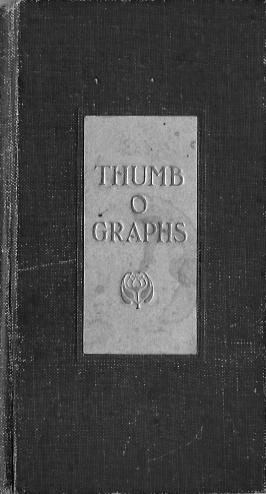
A pocket wonder from the early twentieth century

|
"The latest & newest form of science and amusement is to collect IMPRINTS of THUMBS"
|
| Returning home from a trip to London on October 1 1905,
Frederick Bradford had as always tucked away a little present for each
member of his family, wife Sara received a large bunch of flowers, daughter Elsie
waited her turn and was overjoyed with her novelty booklet in which to
collect 'thumbographs'. 22 year old Elsie soon set about collecting the
thumb prints of family and friends. The Bradfords of the Uplands, Swansea
were first to add their prints and autographs, Elsie was delighted with her new
acquisition and set about gaining more thumbographs.........................
|
|
|
|
|
Frederick Bradford |
Elsie Bradford |
 |
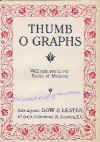 |
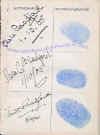 |
| Inside pages. The adhesion mark to bottom right is where the ink pad was attached. | Title page | first page of 'Thumb O Graphs", a family affair, Elsie, Sara C (mum) and Fred (dad). |
| ......................................Elsie's dad Frederick Bradford was a Wine and Spirit Merchant and a member of the Swansea Corporation. A former Mayor of Swansea (1895), he attended matches at St Helen's, Swansea and at the Cardiff Arms Park. Joining him on these trips, daughter Elsie took her little book and obtained the 'thumbographs' and autographs of many famous rugby personalities. In December of 1905 she attended the Glamorgan v New Zealand game at Swansea where she met Corbett & Mynott of the travelling All Blacks. This match was played just 5 days after the All Blacks only defeat against Wales, the All Blacks running out winners in the Glamorgan match 9 - 0, this was their biggest victory in Wales. On 3rd February 1906 Elsie was at the Wales v Scotland match in Cardiff where she collected the 'Thumbographs' of the Welsh team including 10 members of that famous team that inflicted the only defeat on the 1905 All Blacks, amongst these thumbographs was Teddy Morgan (Illustrated below), the man who scored the try in that wonderful victory. |
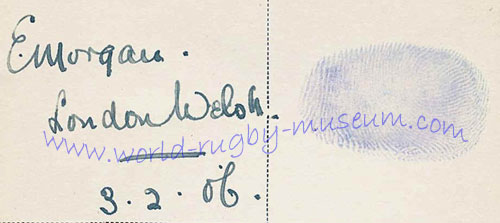
| The Bradford's were probably at the hotel
where the post match function was taking place because on the same day Elsie rubbed shoulders with and acquired
the thumb print and autograph
of the legendary "Welsh Rugby Superstar", Arthur 'Monkey' Gould, captain of the first ever Welsh "Triple Crown" winning team in
1893. Other famous rugby internationals were acquired on this day including Llanelli's first ever
international, Harry Bowen, the man who dropped the goal when Llanelli
defeated the first tourists to Wales, the 1888 NZ Native Touring
Team.
Later that year, Elsie made the acquaintance of the touring South Africans. The Springbok side was famed for re-uniting the people of South Africa after the terrible Boer war. The tourists arrived in Swansea by train at 6.00am on Wednesday 28th November and at 4.00pm on that very same day the Mayor of Swansea gave a civic reception for the Springboks, it was probably at this reception where Elsie obtained the 'thumbographs' of almost the complete tour party. The South African tour manager 'Daddy Carden' states in his report to the South African Rugby Union that 'we had a civic reception at the Guildhall here on the day of arrival, which was a most pleasant social affair. The Mayoress and ladies entertained us to tea, etc, after the usual speeches. Then on December 1st the Springboks played Wales, at St Helen's defeating the home team 11 - 0, a remarkable feat given that at the time Wales were regarded as the strongest team in the world. To view the Thumb O Graphs and autographs of any these great rugby internationals please scroll down or click on the links below.
1905-6 WELSH TEAM & OTHER WELSH INTERNATIONALS - 1906 SPRINGBOKS - COMPLETE LISTING OF ALL PAGES |
|
JOHN CORBETT - 1905 ALL BLACKS
|
|
|
|
Jon
Corbett played for the combined Canterbury-West Coast team against the 1904
British team. He was selected for 1905 All Blacks and went on the preliminary
tour of New South Wales, before departing for Europe. |
|
HARRY MYNOTT - 1905 ALL BLACKS
|
|
|
|
Harry Mynott made the preliminary tour to Australia 1905 before leaving for Europe with the 'Original' All Blacks. Usually a first five-eighth, Mynott made his international debut against Ireland as a wing three-quarter. His normally reliable hands deserted him in the Welsh game, the only loss on the tour when he appeared in his preferred position. However, he retained his place for the French test. Mynott toured Australia in 1907, playing outside Fred Roberts in all three tests. Until Frank Bunce overtook his record in 1996, he was the oldest back to represent New Zealand. He was 34 years and 28 days old when he took the field for his final international, the third test on the 1910 tour of Australia. A brilliant attacking player and also sound on defence Also known as 'Simon', Mynott was regarded as a splendid sportsman. With Jimmy Hunter he formed a formidable five-eighth combination known as 'the Taranaki Twins'. He was a Taranaki selector 1910-14 and an All Black selector in 1913. |
|
ARTHUR GOULD - WALES
|
|
|
|
Arthur Gould was
Welsh rugby's first super star. He was the man who put Arthur Gould was 16
when he first played for But what sort of game
was rugby when the young Arthur Gould first played? Only four years
before, in 1878, Blackheath had introduced wheeling and passing among the
forwards. The previous practice had been for forwards to push and maul
each other for minutes on end. In fact, many clubs were still playing in
this fashion in the mid-80s. It was only in the preceding few months
before Gould's debut that backs were actually beginning to pass to one
another - they ran and played as individuals normally. The majority of
goals was the deciding factor in matches - so there was an inordinate
number of drop goal attempts and tries were not given very much emphasis.
But tackling was fierce and raking and kicking of opponents was an
integral part of play! From his debut for 1885/6 saw He played in This did not augur
well for 1892/3, but Arthur Gould scored 37 tries for his club and
captained In 1896 he decided to
retire, he was comfortably over 30 but was persuaded to return. He made
his 27th appearance for Arthur Gould was a
superb all-round rugby player. He was almost an even-time sprinter. He was
instinctive in dodging, swerving and side-stepping. But he still practised
very hard to improve. He was naturally left-handed and left-footed but
after a short time could kick as well with his right. He was a great drop-
goal kicker and a superb punter, while he studied opponents intensely to
probe for defensive weaknesses. A matchless attacking back and until his
later years a deadly tackler. Gwyn Nicholls summed up his contribution:
'Chief credit for the perfection of Welsh tactics (in the first Golden
Era) can be almost entirely ascribed to Gould. (Text from "A Century of Welsh Rugby Players" by Wayne
Thomas) |
|
JACK BANCROFT - WALES
|
|
Jack
Bancroft has always remained in the shadow of his elder and more famous
brother, Billy Bancroft. Billy was the player to the gallery, the supreme
egotist on the field, while Jack was the steady, no-nonsense,
straightforward traditional full-back. However, Jack scored more points
(88) than Billy (60) did for Wales! Jack Bancroft made his debut for Swansea in 'the
invincibles' of 1904/5- there were about a dozen present and future
internationals playing for the club during that season. In the following
season Bancroft made more appearances but it was 1906/7 before Bancroft
became Swansea's regular full-back and prime goal-kicker. It was in 1908/9 that Bancroft received national
recognition and, like his brother before him, made his debut because the
chosen full-back was injured. Once in the side, Bancroft played admirably,
but he did miss several internationals through injury. Bancroft was chosen
to play against England at the Arms Park in 1909 to make seven Swansea
players in the Welsh side. This selection was based on Swansea's brilliant
6-0 win over the Wallabies when Bancroft kicked a vital penalty. Bancroft
converted one of the tries and then kicked the decisive conversion late on
against Scotland to clinch victory 5- 3. However, he was nearly
responsible though not knowing it for defeat at the end of the game
because he was penalised for lying on the ball. The referee awarded a
penalty to Scotland which was narrowly missed but Bancroft had been kicked
unconscious while falling on the ball! Bancroft had a field day against
the French in 1909, converting six tries, and he banged over another three
in the Triple Crown decider against Ireland. It was a brilliant season for
Bancroft with his 22 points for Wales, he kicked 104 for his club! On New Year's Day, 1910, at Swansea, Wales ran up
her highest ever score in internationals, 49 against France. It was an embarrassing, one-sided affair, which the Welsh players took very
half-heartedly in running in ten tries. But Bancroft took his
opportunities very seriously and steadily kicked eight conversions and one
penalty to set a Welsh record of 19 points in one match. However, the
record slipped out of sight, even if it ever registered, until Keith Jarret's
epic debut equalled it. Only hurried checking through old
copies of the 'Western Mail' on the Monday after the English match in
1967; rediscovered Bancroft's feat! Bancroft
played his part in the 1911 Triple Crown triumph but broke his collar-bone
against the Baa-Baas. He returned for most of 1912 and played his greatest
defensive game in the defeat by England at Twickenham. He was captain
against Ireland but injury cut short the season again. This time he was
out of the game until the latter part of 1913, tragically missing the
Welsh and Swansea matches against the Springboks. He might have drawn the
former game! He kicked the winning points against Ireland in 1913 and
played most of 1914 before injury and war came. Bancroft was not unusually talented, but he
laboured long and hard to improve his play. His kicking was accurate but
not very long. His tackling and falling were solid but his
judgement occasionally lapsed. He would sometimes let the ball bounce
before catching it but his courage was never in doubt. His goal-kicking
was sure and correct and his 88 points for Wales (47 against France) were
a record until Barry John came along. His international record was a good
one as the first Golden Era drifted away, although he was blamed by
several colleagues for the defeat at Twickenham in 1914, which cost Wales
the Triple Crown and Grand Slam. Apparently he failed to mark a ball for
some 'unmentionable' reason!
(Text from "A Century of Welsh Rugby Players" by Wayne Thomas) |
|
GEORGE BOWEN - WALES
|
|
George Bowen won his first Welsh cap in 1887 against Scotland. He won 4 caps as half back or back in total. During his career he played for both Swansea and Llanelli. Bowen was an official at the Ashburnham Tinplate works in Burry Port and served as the Mayor of Kidwelly. An all round sportsman, he also played cricket for Glamorgan. Bowen was a committee member of the Welsh Football Union and ran the line as touch judge in the Wales v South Africa 1906 international at St Helen's. |
|
HARRY BOWEN - WALES
|
|
|
|
Harry Bowen's greatest moment in rugby football was when he dropped a goal from the half way line in the Llanelli defeat of the 1888 New Zealand Native Touring Team. This was the only score in the match in this the first ever touring match in Wales by an overseas team. He captained Llanelli from 1885-87 and played in 4 internationals for Wales 1882-86. Off the field he spent a lifetime in education and ended his working career as a headmaster. He was a WRU selector, an International Board representative (1908) and refereed the 1905 England v Scotland match. He was also the rugby correspondent for the Cardiff Evening Express. |
|
RHYS GABE - WALES
|
|
|
|
RHYS GABE
was seventeen when he made his
debut for Llanelli at centre. He played three games and was promptly
dropped for not being good enough! But one month later he reappeared on
the wing for the club and became a great success. Three years later on
March 16, 1901, at the tender age of 20, he played for Wales on the left
wing against Ireland. The story is told that the week before that
international Llanelli played Swansea and Gabe marked Trew. Knowing that
he was the nominated reserve, Gabe apparently violently tackled Trew, who
was the selected wing, in order to put the Swansea man out of the Irish
match! Gabe played! In
September, 1901, Gabe went to
Borough Road College, London, to take a teacher's training course. He
played both for the College and London Welsh. The College were weak at
centre so he moved in from the wing, which also coincided with the London
Welsh possessing two international wings, Llewellyn and Gabe, and one
future international wing, Morgan. Llewellyn, as club captain, persuaded
Gabe to play at centre and also told the Welsh selectors that Gabe should
be tried at centre with Nicholls. The advice was taken, and against
England in 1902 one of the most brilliant three-quarter lines ever to play
took the field for the first time -Llewellyn, Nicholls, Gabe and Morgan. In
the 1902 Triple Crown side Gabe
laid the foundations of his great reputation. He got an important try in
the 9- 8 win over England and two more brilliant ones against Scotland.
But in the Irish match he defended stubbornly to prove his all-round
ability. In
the 1903 English match J.J.
Hodges got three tries but it was Gabe who made them all. Gabe told Hodges
to start running as soon as the ball was out as he would catch him up
before he had to pass! After the game Hodges said he had received some
'perfect' passes from Gabe! In
the summer of 1904 Gabe went to
the Antipodes under Bedell-Sivright where he proved himself one of the
stars of an outstanding back division, playing in all four tests and
scoring a try in the Final Test against Australia. When Gabe returned he took up a teaching post in
Cardiff and began playing regularly for the club. In the Wales v New
Zealand match, Gabe was the man who drew the New Zealand wing and put
Morgan clear. In 1906 Gabe played four times against the touring
Springboks, for Glamorgan, Wales, Llanelli and Cardiff. The first three
were defeats but Gabe and the Cardiff side played superbly to win 17- 0.
He scored the final try after a brilliant dribble! Gabe captained Wales against Ireland in
1907 and scored a brilliant try, but it was in the following season
against England at Bristol that he scored his most extraordinary
try. There was thick fog over the ground throughout the match and at one
stage he and Percy Bush came upon a loose ball outside the English '25.
After wrestling with each other first, Gabe set off with the ball for the
English line. The English did not know what was happening and Bush further
confused them by running off in an opposite direction, shouting.
Eventually the players and referee arrived at the line to cheers, the
'phantom' Gabe was found alone waiting for his try to he awarded!, At the end of 1908 he retired, but reappeared
occasionally for Cardiff, after scoring 51 tries in 115 appearances. He
formed with Gwyn Nicholls probably the greatest ever centre pairing for
club and country, in combination they were devastating both in attack and
defence. Gabe himself had a very individual style. His running was very
straight and resolute although he had a brilliantly deceptive swerve. His
build was sturdy but to the would-be tackler he seemed all elbows and
knees, and he had plenty of speed. However, his cleverness and judgement
were his greatest qualities both as a brilliant attacker and as a very
sound defender. (Text from "A Century of Welsh Rugby Players" by Wayne Thomas) |
|
REGGIE GIBBS - WALES
|
|
Reggie
Gibbs played 16 times for Wales as a back. He was a prolific try scorer
averaging more than one a game, with 178 in total. He appeared for Glamorgan against New Zealand in 1905 and scored
a try for Cardiff against South Africa in 1907. He scored six tries in
four matches in the 1908 season, which included four tries against France
in their first ever match against Wales. He captained Penarth in 1903-04
and Cardiff in 1910-11 and Wales against Ireland in 1910. In January
1911 he scored 30 points for Cardiff against Moseley. He was the top
scorer, with 28 points in ten appearances for the Anglo- Welsh team in New
Zealand in 1908. He played cricket for Glamorgan and was a first class
billiards player. His daughter, Shelagh, played golf for Glamorgan and
Wales. |
|
WILLIE ARNOLD - WALES
|
|
Willie
Arnold played for Wales as a wing
in 1 match against Scotland in 1903. Arnold was a prolific try scorer,
during the 1902- 3 season he scored
thirty-five tries for Llanelli and at Swansea, a season later, scored a
further thirty-two tries. He played in the unbeaten Swansea XV in 1904-5
and appeared for Glamorgan against New Zealand in December 1905. In 1906
he played for
Llanelli against South Africa. A keen all-round sportsman, he
served on the committee of Glamorgan County Cricket Club and was the first secretary and
one of the founders of Morriston Golf Club. During his career his weight
fluctuated between 8 st 7 lbs
and 9 st. His brother Arthur played for the Swansea 2nd XV. |
|
ARTHUR FLOWERS 'Boxer' HARDING - WALES
|
||
|
|
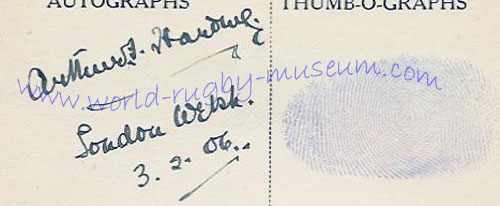
|
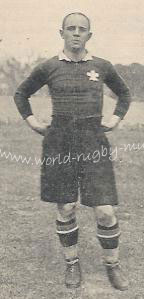
|
|
Arthur
Flowers Harding, nicknamed 'Boxer; played a major role in the Welsh win over the
All Blacks in 1905, but he emigrated a few years later to New Zealand and died
there in
1947 after over thirty years' contented residence. Indeed, in 1914 he
played for Wanganui -where he lived-against Manawatu - at the age of 34! Harding
was 22 years of age when he made his debut for Wales against England at
Blackheath in January, 1902. Wales won a thrilling match and had taken a huge
step towards her third Triple Crown. Harding
had had a rapid rise to the national XV, being in only his first season with the
Cardiff club. He was a dashing forward in open play, possessing great speed and
versatility. In fact, his style of play- in an era of slowish, solid-scrummaging
forwards -was more akin to a three-quarter. He could run and pass and was able
to kick extremely well. However, he was a solid scrummager and a truly brilliant
dribbler. When Harding first played for Wales he was extremely fortunate to be
alongside the incredible George Boots and he learnt a great deal about loose
forward play from him. In
1902 Harding played well throughout, supplying a great deal of pace around the
field to halt the great Scottish XV at Cardiff and an unyielding commitment to
supplying the backs with enough ball to outlast and outwit the Irish in Dublin
for the Crown. But the following week Harding was put out for the rest of the
season by some nameless Swansea forwards, being 'charged' in making a mark! Early
in the 1902/3 season, Harding left South Wales to live in London. He joined
London Welsh who at that time, included such players as Llewellyn, Gabe, Morgan,
J. C. Jenkins and J. F. Williams. For
the 1903/4 season Harding was chosen to captain London welsh, a position he also
held for the following three seasons. After playing in all three internationals
Harding was one of two Welsh forwards included in Bedell-Sivright's British side
to Australasia during the summer of 1904. The tour was successful with the so-
called Anglo-Australian XV winning every match in Australia, including three
tests, but the only test in New Zealand was lost. Unfortunately the side were
not good enough at forward, but the backs were superb. He kicked a penalty goal
in the first-ever Test match against the All Blacks. Although Harding tried his
best, the Lions eight, tired at the end of a long trip, could not match
Gallaher's pack. 1905
saw Wales's fourth Triple Crown with Harding ever present and Middlesex, with
several London Welsh players, reach the County Championship final. But the
following season, 1905/6, saw the arrival of the first touring All Blacks.
Harding, along with his fellow 1904 tourists, felt that Wales could beat New
Zealand. The Welsh team went into a huddle to plot for victory. Harding, along
with J. F. Williams, had played against the All Blacks for Middlesex. Although
overwhelmed 34 -0, the Middlesex forwards did unmask the All Blacks loose-head
manoeuvre (see details on 'J. J. Hodges') but were unable to create a counter
during the game. When Harding met up with Hodges and the rest of the Welsh pack
a counter was found. In the game itself Harding twice could have got close to
tries if he had steadied himself. However, in the last ten minutes, as the All
Blacks swarmed dangerously into the Welsh '25; Harding coolly dribbled
the ball out of a loose scrummage and down into the All Blacks `25 ’ before it
was scrambled into touch! After the defeat by the 1906 Springboks Harding was one those dropped,
only to return as a back or forward (Text from "A Century of Welsh Rugby Players" by Wayne
Thomas) |
||
|
JEHODIA HODGES - WALES
Hodges
made his mark very quickly in first-class rugby, making his debut for
Newport at the beginning of the 1897/8 season and being picked for Wales
in January, 1899, against England, when barely in his twenties. He was not
as big as other Welsh forwards of the time, weighing around 13 stone and
being about 5'9" in height. He was described early on as a
hard-working, good all-round forward but later in his career he was
reputed to have developed into the most dashing forward in Wales. An
excellent all- round footballer he played in almost every position in the
backs, whilst filling in for players who had to retire injured. And in
1903 for Wales against England, when he had to go out on the wing to
replace the injured T. W. Pearson, he ran in for three tries! Boots
and Hodges always provided the 'brains' of Newport and Wales packs
throughout the initial years of the century. But Hodges was often accused
of playing at three-quarter effort in ordinary matches, reserving his best
play and performances for the really big occasions. Hodges
figured in three Triple Crown winning sides as well as in the victory over
New Zealand in 1905. 1905 also saw Wales's first win in Scotland, which
included an all-out fight between the packs! The story of
the 1905 win against the hitherto invincible All Blacks must
include the brilliant Welsh scrummage preparation. New Zealand packed 2-
3- 2, with a rover, against three front row men. The two waited for their
opponents to get down first and promptly followed suit against the outside
man of the opposition, in order to gain the loose head, leaving the other
member of the opposing front row with nothing to push against. Before the
latter could move, the ball was put in and out! Wales decided to counter
this tactic by only Hodges played against the All Blacks for his club a week later but, despite a brilliant second half forward display, they lost 3 -6. Sadly, 10 months later against the Springboks, Newport again lost narrowly. He played his last international in 1906. The next season he was badly injured. Wales played South Africa without him. Instead of Welsh scrummaging know-how winning the day, the tourists packed 4 - 3 -1 and crushed a totally bemused Welsh pack. Hodges played one more season for Newport before going to finish his playing days, six years later, in the Monmouthshire League. A brilliant forward and leader he gave so much to his team mates. (Text from "A Century of Welsh Rugby Players" by Wayne Thomas) |
|
DAI 'TARW' JONES - WALES
|
|
|
|
Dai 'Tarw'
Jones was a giant of a man for his time, for he stood around 6' 1"
tall and weighed well over fifteen-and-a-half stones. A coal-miner by
occupation, working in the heart of the Rhondda Valley, he was part of the
legend that grew up around the turn of the century concerning Welsh
forwards. In
the first fifteen years of international rugby, Wales was not 'hard
enough' up front, but gradually the first Golden Era dawned, blessed not
only with some of the greatest backs but some of the toughest and roughest
forwards Wales has ever possessed. Dai Jones fitted the bill perfectly-
big and heavy, fearless on the field, with a strong and energetic 'style'
of forward play, based on a terrific scrummaging ability. Jones was lucky
to come into the Welsh XV at a time when Hodges and Boots were
master-minding the Welsh forward effort, for he learnt a lot. Jones
began his playing career with Treherbert-a second class Glamorgan League
side -but it was not unusual for these clubs to provide internationals at
the time. Treherbert won the League three times in succession in the
1900s, beating stronger clubs. But it was his performance on his home
ground in 1901/2 in a Welsh trial that brought Jones international
recognition against England in 1902-he was only 20! Jones played
throughout 1902, 1903 and 1905, by which time he had switched allegiance
to Aberdare. During this time Jones was also a regular in the invincible
Glamorgan county side. When the great match against the All Blacks was
played, Jones proved himself a hard, uncompromising player in the terrific
forward battle. But later in the season his form weakened and he did not
travel to Ireland as he had an intense fear of boats! His last match for Wales was against South Africa in 1906. He had already played an important part in Glamorgan's narrow 3 -6 defeat by the tourists, but in the international Jones looked unfit and 'over the hill; He did not last the eighty minutes and his scrummaging was poor, which meant that the pack, containing too many 'loose' forwards, fell apart in front of an inspired Springboks pack, It was a tragic end for 'Tarw' at twenty-five years of age. He then played as a professional for Treherbert Northern Union. (Text from "A Century of Welsh Rugby Players" by Wayne Thomas) |
|
DICK JONES - WALES
|
|
Dick
Jones of Swansea was a very good outside half -probably a great one -but
his individual reputation has always been overshadowed by the reputation
he enjoyed in combination with
Dicky Owen, his club and international scrum-half partner. Like Owen,
Jones came into the Swansea side after the brilliant James brothers had
given up the game just before the end of the nineteenth century. Almost at
once the puny Owen and the handsome Jones struck up an almost telepathic
understanding. Incredibly, the club champions lost two legendary
half-backs only to see them replaced by an even greater pairing, and the
title continued in Swansea's safe grip. Jones
was a brilliant runner, who could dodge, jink and swerve very cleverly.
His kicking also marked him out for he was one of the first halves to mix
running with kicking in offence. But it was his judgement that made him
stand out for he was a greater thinker than many players who had more
ability than he had. Gradually Owen and Jones were able to anticipate
immediately and intuitively the other's forthcoming move. Both were always
looking for new ways of doing things -so much so that opponents never knew
what to expect of them. As a result, when sides tried to plan a defence,
they were at a loss and so apprehensive that they often failed to organise
anything. If the opposition did manage to play well enough to contain
Jones and Owen, then this would be just another challenge for the pair to
raise their game to an even higher plane. Welsh
selectors have always been in favour of playing club pairings at half-back
and, in 1901, after Newport's Phillips had broken down in the Scottish
match, Jones and Owen were called up for their first caps against Ireland.
It was the first of fifteen appearances together for Wales - a
record not beaten until John and Edwards. Wales were fortunate to win and
the Swansea pair hardly distinguished themselves. Jones and Owen played
against England in 1902 but then Jones was dropped in favour of Lloyd,
whose form was such that the advantage of club pairing was not enough. Although
Jones continued to play brilliantly for his club and Glamorgan he was not
picked again for Wales until 1904, when he proved his class by some superb
kicking to defeat Scotland and some magnificent running and support play
against Ireland. 1904/5
was the year of the Swansea 'Invincibles' and Jones, with Owen, was at the
top of his form. His superb running carved out opening after opening
against England, and Wales ran in seven glorious tries. But two weeks
later at Newport Jones broke his instep in a club game and he did not play
rugby again until November 2, 1907. Jones
returned against France in 1908 and then starred in the Triple Crown
decider against Ireland by making the winning try. 1908/9 brought Wales
five wins-Australia and the Grand Slam- and Jones and Owen master-minded
some excellent play. It was a year in which the pack struggled for parity
but superb back play ensured enough scores for victory. 1910
brought a sad final game for Wales for, after taking France apart on New
Year's Day, Wales headed for Twickenham. But England beat Wales for the
first time in twelve years. Jones and Owen were dropped and while Owen
returned in 1911, a serious accident ended Jones's career prematurely. (Text from "A Century of Welsh Rugby Players" by Wayne Thomas) |
|
WILL JOSEPH - WALES
|
|
Will
Joseph was one of the forwards who were the backbone of the early
triumphs of the first Golden Era. A tall, handsome man, well over six feet
and around thirteen stones, he was the outstanding Swansea forward in an
outstanding pack in the early part of the century. The Swansea Club were
invincible in 1904/5 and the pack included several internationals. In
the first Golden Era, forwards were picked for their all-round abilities
with an emphasis on scrummaging as there was little specialisation and
scrum ball, in a period before defensive wing forwards, was the crucial
possession. Joseph was noted for his brilliant work in the tight scrums,
but, because of his height, he was also very good at the line-out (not
that forwards got too far off the ground in those days!). Another
essential forward skill was dribbling and Joseph was very adept at it. He
could also tackle with deadly certainty. Joseph
was 23 when he made his first appearance for Wales against England at
Blackheath in 1902. He had only played a couple of seasons' first-class
rugby for Swansea, following experience with Morriston. In the stern
struggle Joseph quickly made his mark and was also outstanding in the
following game against the 1901 Triple Crown holders, Scotland. He was
only to lose his place once - through injury -until after the debacle
against the South Africans in 1906 –a measure of his tremendous fitness
and form. His physique and power stemmed from the fact that he was a
tin-plate worker, which was a hard, demanding job before automation. When
the All Blacks arrived in the autumn of 1905, Joseph lined up against them
three times within a fortnight. For Wales, he stood staunchly firm and
rugged in the titanic forward struggle; for Glamorgan, he led the
'under-strength' county side with fire and purpose, even taking the
penalty attempts; and for Swansea, his physical presence and superb
tackling almost brought the club a famous victory. Tragically,
the 1906 Springboks never played Swansea, for they might have been beaten
by such a strong side, but Joseph played twice against them. First, for
Glamorgan, when he scored the home side's try in a narrow defeat by a badly shaken
Springboks and, secondly, for Wales when, although he personally played
with credit, the pack fell to pieces. The cry went up for 'old' heads to
roll and Will Joseph at 28 ˝ apparently
was past it. He was dropped and faded out of first -class rugby soon
afterwards. (Text from "A Century of Welsh Rugby Players" by Wayne Thomas)
|
|
HOP MADDOCK - WALES
|
|
|
|
Hop Maddock played on the wing for Wales in six matches between 1906 and 1910. He played for Glamorgan against South Africa in 1906 and captained London Welsh in 1909-10 and 1911- 12. Maddock was employed by the London County Council. He died from the effects of wounds sustained during the First World War during which he had served in the Royal Fusiliers (Public Schools Battalion) and in the Machine Gun Corps. |
|
IVOR MORGAN - WALES
|
|
Ivor
Morgan stood out in any company-he was a chunky, 5' 10," tall,
auburn-haired, dashing forward. In the 1904/5 season Swansea were
invincible, with a formidable pack including a But
in his early period with the club Morgan tended to be overshadowed, first
by Fred Scrine, and then George Hayward, both international wing-forwards. However, although Morgan could play the all-round forward game
of the time -his build allowed him to do that -he slowly began to develop
a new type of wing-forward game. There had already been running and
handling forwards and the beginnings of destructive, defensive back row
play, but Morgan perfected the attacking, wide-ranging, opportunist,
try-scoring, loose-forward style of play. One
of the reasons for Morgan's style was that he played wing-forward to one
of rugby's true innovators, Dicky Owen, who was always creating new ploys
and ideas when Morgan came into the Swansea side Owen's usual partner,
Dick Jones, was injured and did not play for over two years. As Billy Trew
did not play too often then at fly half, Owen was forced, in the absence
of real decisiveness in the Swansea midfield, to concentrate more on
creating openings from his own running. With Morgan, Owen formed an almost
telepathic understanding and, as a result, Morgan became a prolific scorer
of tries. Time and again at club and later at international level, Owen
would dart away from a scrum or loose scrummage, make a half-opening and
pass to the red-headed shadow at his shoulder, who would crash over for a
try. His record for Swansea is impressive - 1908/9-18 tries; 1909/10-9;
1910/11-17; 1911/12-8. While he crossed six times for Wales in 13
appearances. The
qualities that brought Morgan to be acclaimed as one of the greatest
wing-forwards of all time were many. He possessed exceptional speed -an
unusual characteristic for a forward of the period -as well as having the
hands and swerve of a centre three- quarter. In fact, he played at centre
against the Barbarians on one occasion (scoring two tries against an
international centre), on another he substituted for Dick J ones when he
left the field injured! Defensively he was very good, often 'shielding'
Owen from trouble around the base of the scrum, while his pace enabled him
to cover and tackle excellently. Morgan could also take the rough and
tumble of forward play, and between 1904 and 1912 he was the backbone of
Swansea's great forward strength. Morgan
was selected for his first international against the 1908 Australians. He
was not a popular choice, but Billy Neill the Cardiff loose forward -had
gone 'North' and left a place open. In a gruelling forward battle the
Welsh eight's speed away from the set pieces, particularly Morgan's,
enabled the home side to squeeze in 9-6. However, the performance that
really stamped Morgan as a player of class was the superb display he gave
for his club against the Wallabies. Swansea won 6 -0. Morgan
played throughout the rest of the international season as Wales took the
Grand Slam. In 1910 he scored two tries against
France at Swansea before taking part in the opening match at Twickenham.
Opposite him was Cherly Pillman, a brilliant all- round wing-forward, who
could not only disrupt backs, but was also a brilliant attacking runner
(he played fly half for Britain in a test in South Africa in 1910!).
Unfortunately Morgan was forced by team strategy to playas a scrummager
rather than being allowed his natural free-ranging game. As a result,
Pillman roamed free to upset Owen and Jones and the 'bogey' was born! 1911
brought Morgan and Wales revenge over England, and another Grand Slam.
Against Ireland, to take the Triple Crown, Morgan continually led the
Welsh pack with surging foot rushes and close passing movements. In
1912 Morgan was in towering form with Trew and Owen at half-hacks, but the
Welsh selectors wanted eight scrummagers at Twickenham so he was left out.
On the day Wales were disjointed and England, with Pillman, swept to
victory. But Morgan and Trew returned against Scotland and Wales stormed
to a 21-6 win, with Morgan getting a typical try. Unbelievably, he was
dropped for the Irish game and not recalled against France. At the end of
the season he retired. At 27, a sad loss to the game, a man before his
time.
(Text from "A Century of Welsh Rugby Players" by Wayne Thomas) |
|
TEDDY MORGAN - WALES
|
|
On
December 16, 1905, just before 3 o'clock, Teddy Morgan was put clear by a
superb pass from Rhys Gabe about 30 yards out from the opposition goal
line. He went for the line at top speed as
the full-back raced across to cut him off. In a flash he was diving over
in the corner with the full -back just unable to cut him off. Wales were
in the lead 3-0 which was to remain the score at full time. In
succeeding years it became clear that Morgan had scored probably the most
famous try in Rugby Union, for it was the score that enabled Wales to
defeat the first New Zealand touring team. But
Dr. Teddy Morgan, as he became, of Guy's Hospital, is not only remembered
for one legendary effort. He was one of the most brilliant wings ever to
play for his country. Indeed, as a pair, Morgan and his school and club mate, Llewellyn, are the greatest to have ever played together for
Wales. He was exceptionally fast, but able to dodge, weave and, most of
all, swerve, with no apparent change of pace. His greatest talent lay in
wrong-footing defenders by feinting to swerve inwards; sometimes he would
do it twice, and then leave them on the outside with an extra burst of
speed. He could kick well in attack and defence, being particularly
supreme at the cross-kick. His defensive catching and tackling were
exceptional and often he would cut across from his own wing to tackle
somebody in the opposite corner. Morgan
made his debut for Wales in 1902 and what had brought him to the attention
of the selectors was his performance as a guest for Newport at Blackheath
on October 26, 1901, when he scored three remarkable tries. Immediately,
he had been acclaimed as a future international. Morgan was ever present
in the Triple Crown-winning side of 1902. Injury
kept Morgan out of the Welsh XV until the game against Ireland in 1903. He
made a brilliant return, racing over for two fine tries. In 1904 Morgan
scored in every international and went off to the Antipodes with
Bedell-Sivright's British side. As with the rest of the star Welsh backs
on tour, Morgan revelled in the hard grounds in Australia and was first
choice on the left wing. He scored in the Third Test and seven tries in
all on tour. He also took over as captain because
of injury for the Second and Third Tests against Australia and of the
first British team to playa full international against New Zealand -a
debatable choice as Llewellyn was the Welsh captain at the time. It
probably owed more to his medical connections- the manager was also from
Guy's! In
1905 Morgan proved his greatness by scoring twice against England and
getting the clinching second try against Ireland in the Triple Crown
decider. When the All Blacks came to play Wales, Morgan took his place
opposite McGregor, who had scored the two winning tries against Britain in
1904. Morgan tackled him ruthlessly throughout. He was also responsible
for adding to the controversy as to whether Bob Deans 'scored' or not.
Morgan claimed Deans had scored, saying on the one hand that when he got
to Deans, he had grounded the ball over the line, while, on the other
hand, he actually claimed to have tackled Deans (he could not have done
both!). Gabe is generally reckoned to have tackled Deans with the help of
Cliff Pritchard and others. When
the Springboks arrived in 1906 Teddy Morgan led Glamorgan against them. In
a superb game, after going 0- 6 behind, Morgan rallied the county side
only to lose in the end 3 -6. But in the Welsh match he had little chance
in attack, although his stern, un-yielding defence was as good as ever. After this match Morgan only played once more for Wales - as captain against France in 1908. First injury, and then his doctor's duties kept Morgan from first-class rugby. But he scored 14 tries in 16 internationals.
(Text from "A Century of Welsh Rugby Players" by Wayne Thomas) |
|
GWYN NICHOLLS - WALES
|
|
GWYN NICHOLLS wrote
a book shortly after his retirement. Two statements from it illustrate
the man and his play. The Welsh or modern game is essentially the total
merging of the player in his team. He is no longer even a unit, but
rather an integral part of the whole' and it is the ability to
"draw" two or more opponents that a three quarter should most
prize. He was acclaimed in his day as a superlative centre three-quarter
and was regarded by all who saw him as the greatest centre playing under
the four three-quarter system. But why was he
regarded at the 'Prince of Centres'? Primarily he had the supreme gift
of being able to read the game and judge what was most required at any
moment. In attack, he usually subordinated himself to his wing, being a
master at giving and taking a pass, but he could also burst for the line
himself with great speed or a swerve. He scored 111 tries in 242
appearances for his club, Nicholls was a big
and strong young man who made his debut for In the summer of
1899 Nicholls toured Wales won the
second Triple Crown and it was Nicholls who made the only score of the
match against the Irish in Belfast by beating his man before handing on
to his co-centre, George Davies, to crash over for the decisive try. In
the next season Nicholls scored a dazzling try against 1902 saw Nicholls
become the Welsh captain, in succession to Billy Bancroft, and the
Triple Crown was gained for the third time. Nicholls himself scored a
drop goal and a try against At the age of 30,
Gwyn Nicholls, already four times captain of his club, felt he ought to
retire before the 1905/06 season began. But he did not and he was chosen
to lead Nicholls, soon
afterwards, scored one try and made the other in However, on New
Year's Day, 1907, Gwyn Nicholls bade farewell to top-flight rugby in
real style. He was the brilliant general of a fine back line, running,
passing, kicking and tackling superbly in swamp-like conditions, to
crush the Springboks by 17 -0. He then retired. Tragically his health
was never good after 1923 when he made an attempt to rescue a young girl
from drowning at Weston. He suffered from nervous trouble and he died
just before World War II, mourned by all. (Text from "A Century of Welsh Rugby Players" by Wayne Thomas) |
|
DICKIE OWEN - WALES
|
|
Over
one hundred and twenty five years Wales has produced many excellent scrum halves -both
capped and uncapped -but three stand out as pre-eminently great: R. M.
Owen, W. H. Tanner and Why
Dicky Owen? To begin with, he won 35 caps, a feat not beaten until Ken
Jones in the early fifties. For almost all the first Golden Era he was the
first choice of the Welsh selectors as scrum half and as the side's
tactical lynchpin. For almost a decade Dicky Owen took on all comers from
the home countries, and notable half backs from New Zealand, South Africa
and Australia, and stood without equal the greatest scrum half of the day!
He
was pathetically small and frail-looking -his pictures show him to be
almost a dwarf with a puny, shrivelled face. He was 5' 2" tall and
about 9 1/2 stones in weight. It is incredible that he survived so
long without too many injuries, as forwards were not too particular about
who and what they kicked before the Great War. Owen was certainly a target
for 'spoiling; but he possessed an iron constitution which meant he could
survive the hardest knocks. He was also a fearless faller on the ball and
a demon tackler of the biggest of men! Owen
came to prominence very quickly with Swansea around the turn of the
century. He followed the legendary Evan and David James who played for
Swansea and Wales in the 1890s. At the same time, Dick Jones came into the
Swansea side as fly half and Owen and Jones almost at once picked up where
the James brothers left off. But whereas the James brothers used to enjoy
playing by themselves, Owen and Jones became the first half-backs fully to
combine tricky half-back play with running three-quarters. Owen
was a brilliant innovator, always seeking to perfect new moves and ways of
unsettling the opposition. Rugby was almost a religion to him and he was,
and still remains, one of the game's real formative influences. While most
people were content with the development of the game by the turn of the
century (for it had changed out of all recognition from the game of the
1880s), Owen continually experimented to outwit opponents. He became a
master of the surprise attack from unexpected situations. He developed the
tactics of feint attacks and was the first to realise the potential of a
scrum half linking with wing forwards in offensive moves. Here, of course,
he was helped by the great wing-forward play of Ivor Morgan. He
was the pivot of play with a swift rocket-like service that some
fly-halves, especially Bush, found difficulty in making best use of. He
played far better for Wales with Jones and Trew but was still able to
partner the quixotic Bush to beat the All Blacks in 1905. Owen was an
individualist and expected his outside half to be anticipating his playing
decisions. But he was unselfish, wishing to make the most out of others. He
made his debut against Ireland in 1901 in partnership with Jones. They
replaced the Newport club pair, because one of them was injured. He had
only a moderate game after injuring his shoulder Indeed
the 1905 Wales and New Zealand international owes much to the genius of
Owen. The All Blacks played a 'rover' whose role was to put the ball in
the scrummage and act as a destructive wing-forward. The New Zealand
captain Dave Gallaher was an expert in this role. All afternoon Owen had
to withstand the close- quarter 'rough-house' attentions of a man about
ten inches taller and four stone heavier intent on 'burying' him beneath
the turf. Owen suffered a rib injury and was punched but outstayed the All
Blacks. His genius created the movement to break the hard defensive
deadlock. He decided to play on the All Blacks' fear of Bush, who had been
to Australasia in 1904, by passing to him. However, Wales played a rover
as well in Cliff Pritchard, and he was to be used when the tourists least
expected it. After pre-match training the move was to involve Owen
dummying to pass to Bush and then reverse passing to Pritchard. After 20
minutes Gwyn Nicholls gave the signal in the centre of the field near the
All Blacks' ten-yard line to initiate the move. From a scrum Owen moved
right then reverse passed to Pritchard who managed to scoop the ball up
from the turf (Owen's injured ribs prevented him passing properly). It was
three to two and Teddy Morgan outflanked the full-back to score the
decisive try. Owen
nearly won Swansea the match against the same All Blacks but his 'try' was
disallowed. There were many more triumphs for Owen after this -a
courageous match against overwhelming Irish forwards to take the Crown in
1908; a big part in the 1909 and 1911 Crown-winning sides; captain of
Wales on three occasions; and a big part in Swansea's triumphal march on
the club front. It was fitting that he was carried off shoulder-high from
his last game for Wales after a superb performance as player and captain
against Scotland at Swansea in 1912, when he was 35! (Text from "A Century of Welsh Rugby Players" by Wayne Thomas) |
|
CHARLIE PRITCHARD - WALES
|
|
Before
dawn broke on August 13, 1916, a 33-year-old captain in the 12th Battalion,
South Wales Borderers, was brought into No.1 Casualty Clearing Station in France
badly wounded. He
had been carried back after taking part in a raid on the German trenches, which
had achieved its objective of taking prisoners. He had been at the Western Front
for just over two months. His last reported words were as follows: Captain:
'Have they got the Hun?' Reply: 'Yes, he's all right ; Captain: 'Well, I have
done my bit; He died without leaving the Station on the following day. It
sounds like a film script but it is not. It is the official record of the death
of 'Charlie' Pritchard. For his part in the action he was mentioned in
dispatches. His death was seen to epitomise the glorious sacrifice of the 'best
sort' of young British manhood in the Great War. The
descriptions of him in life bear out the manner of his dying. He was like a lion
on the field, off it he was extremely gentle, tender and lovable. In his play he
was an untiring worker with almost inexhaustible energy. Although not a
specialist, he more often than not played in the back row. He played with great
fire and exuberance and was a very difficult player to stop. He had an excellent
swerve in open play and always seemed to sustain a resolute forward momentum in
the mauls and tight play. His passing was excellent while he could scrummage and
dribble as well as any player. But his most important asset was his deadly
tackling. George Travers said of his performance against the 1905 All Blacks
-'he sent 'em down like ninepins. He
stood an inch or so under six feet and was about 13st. 10lb. He
made his first-class debut for Newport against Swansea in January, 1902, at the
tender age of 19. At the time Swansea were undefeated and had been Welsh club
champions for the previous three seasons. In front of 12,000 people at St.
Helens, Pritchard and Newport triumphed. In the following season Pritchard was a
regular and his club toppled Swansea from their position of Welsh champions.
Pritchard made his international debut against Ireland in 1904 after being third
reserve! The
1904/5 season was a miserable one on the club front for Pritchard but Wales won
the Triple Crown for the fourth time. However, Pritchard was unlucky to miss the
deciding match against Ireland through injury. But he was back to full fitness
and in tremendous individual form during 1905/6. He had to take over the club
captaincy from early on in the season, and led his club against the touring All
Blacks. But
it was at Cardiff that Pritchard had his finest hour in the red jersey. The
seven Welsh forwards battled hard all the way against the All Blacks and many
felt that Pritchard was the best forward on the field. He tackled and played
with grim determination, besides which he, to quote one report, 'took his
gruelling like a man; A week later Pritchard, despite brilliant Newport forward
play, had to concede defeat to the All Blacks by 3 -6. In
the following season Pritchard played the best rugby of his career and was one
of only three who played up to form and reputation for Wales in the tragic
defeat by the Springboks at Swansea in December, 1906. But earlier Pritchard had
captained Newport against the tourists and, after conceding two early scores,
severely shook the Springboks, only to lose 0 -8. Pritchard was a popular Newport captain but he was not very successful in terms of results. He suffered serious injury early in 1908 and did not return until the 1909/10 season, when he recaptured his form splendidly. He played twice more for Wales, his last being the opening match at Twickenham. He then withdrew from the Scottish match apparently in order to give club-mate Jenkins a cap. He retired at the end of 1911 (Text from "A Century of Welsh Rugby Players" by Wayne Thomas) |
|
FRED SCRINE - WALES
|
|
Fred
Scrine played three times for Wales 1899 - 1901. His proudest moment on
the field was when he scored the only try of the game for Swansea against the 1905 All
Blacks. Worth only 3 points at the time, the All Blacks triumphed at St
Helens with a drop goal by Wallace, worth 4 points at the time. In 1907, he received a temporary suspension by the Welsh
Rugby Union for using 'improper language to a referee'. Originally a
plasterer, he later became a licensee. |
|
WILLIE TREW - WALES
|
|
W J.
'Billy' Trew has been acclaimed by all as not only a great player, but
as a truly creative rugby genius. This must be praise, for he was
playing in an era which boasted the likes of Nicholls, Bush, Owen, Gabe,
Vile, Dick Jones and W. J. Bancroft. He
was a slightly built, frail, ghost-like figure -around 5' 8" tall
and under 11 stones in weight. He suffered numerous injuries during his
career but always seemed able to recover very quickly. So much so that
his career spanned some sixteen years with his club and fourteen seasons
for his country. He also retired from playing about ten times -and
returned! Trew
made his first appearance for Swansea at 17 against Penarth in October,
1897, and immediately made his mark. He played most of his early rugby
for club and country on the wing, but later he was to prove himself even
better as a centre or fly- half. The 1898/9 season saw Swansea emerge as
Welsh Club Champions, a title only lost once in the following six
seasons. It was an incredible phase of domination, especially as Cardiff
and Newport were so powerful at the time. Trew became the most prolific
try-scorer in Wales- 33 in 1898/9 and 31 in 1899/1900. Not surprisingly,
he was selected to play for Wales against England on January 6, 1900-
the dawn of the first Golden Era. He did not have an outstanding
international season but scored a try against England. After
being injured during 1900/01 and 1901/2 Trew was unable to break back
into the national XV- the likes of
Llewellyn, Morgan, Gabe and Nicholls were in situ. In fact,
before Trew, established himself in 1907, he only played three
internationals! And his form in those games was disappointing,
especially as he had scored 128 points including 29 tries for his club
in 1903/4, and 1904/5 had seen him as an integral part of the Swansea
‘Invincibles’. He
was elected captain of the Swansea club for 1906/7, a position he
retained for the following four seasons and made it six in 1912/13.
Injury prevented Trew from turning out for Wales against the Springboks,
but after that disastrous defeat he took over at fly-half against
England. It was a crushing victory by 22 points to nil and Trew at last
played to his ability at international level. In the following match
against Scotland he captained Wales for the first time and it was the
last time that Wales fielded eight backs and seven forwards. Wales lost
with fourteen men. However, he withdrew from the Irish match, apparently
because he disagreed with a suspension handed out to a team-mate by the WRU.! 1908
saw Trew at centre with Gabe and the first Grand Slam. He scored tries
against England, Scotland and France while his wing, Reggie Gibbs, got
six in the four matches. The following season, 1908/9, Trew
as captain for all five games. It brought the Triple Crown, the
Grand Slam and a victory over the touring Australians. Trew played
alongside Jack Jones (Newport) in the centre. Against Australia Trew was
kicked on the head but returned to direct his side’s victory after
treatment. Two weeks later Trew led his club superbly in defeating the
tourists. Earlier in the Golden Era the captaincy had been passed around
for the honour, but once in harness, Trew was the acknowledged leader
and master-minded triumph after triumph. Although beaten at forward in
1909 by England and Scotland the Welsh backs created enough to get
through. Trew himself got three tries against France and one in the
final match against Ireland. In
1910 Wales lost for the first time since 1898 to England on the occasion
of the opening of the Twickenham ground. The Twickenham 'bogey' had
started, and Wales, for once, could not finish off the chances that were
offered. At the age of 31, Billy Trew led Wales in the 1911 campaign to
a third Grand Slam. It was his greatest piece of leadership for Wales
and he did it as fly-half to Dicky Owen! In fact, Trew's versatility was
incredible -he played indifferent Triple Crown years as wing, centre and
fly- half! Although 1911 owed much to Cardiff's all-international
three-quarter line, it was Trew's brilliant tactical and strategic
captaincy in the close fought victories over England and Ireland that
was decisive. In
1912 Trew was absent from Twickenham through injury, but he watched the
match and landed himself in court for being drunk and disorderly in the
Strand. He returned to be carried shoulder-high after a crushing victory
over Scotland, but both he and Owen preferred to play for their club and
missed the last two internationals of the season! In
1912/13, he led his club from centre against the touring Springboks.
Swansea led by a try to nil at half-time after playing with the wind. In
the second half - for a time with 14 men - Swansea defended brilliantly
against foot rushes and passing movements.
Trew marshalled the defence, sometimes pulling out three forwards to
play as backs! It worked -Swansea held on to win. This was incredible
for he had been reported as suffering a slight nervous breakdown two
weeks earlier! On the strength of this, he was recalled to lead a very
inexperienced Welsh side in Edinburgh, and Wales snatched a surprise
victory. He then went on to Paris where Wales won, but Trew, very ill
with a groin injury he suffered in the game, had played his last
international. Billy
Trew was a superb individual player with a brilliant swerve and dummy.
And, although he was so slightly built, he was a courageous defender who
could time his tackles superbly. In his early days as a wing he was
brilliant at scoring corner tries. As a midfield creator he was a true
genius, for his greatest talent was superb combination with those around
him. He had incredible timing and execution in his passing. Trew also
had a lot of speed, for he had been a junior sprinter of some note. A boilermaker by trade and later a publican, he was to die tragically early in the mid -twenties.
(Text from "A Century of Welsh Rugby Players" by Wayne Thomas) |
|
TOMMY VILE - WALES
|
|
|
|
TOMMY VILE was
an international in three spheres: as a player, referee and
administrator. His playing career extended from 1900 to 1921. He began
refereeing soon after and in no time at all became the most popular and
best referee in Britain. After World War II he represented Wales on
the International Board for seven years before becoming President of the WRU. in 1955. If that was not enough, he was also a J .P., a successful
businessman, and a High Sheriff of Monmouthshire! But
Vile had to wait until January, 1908, before he played for Wales. However,
he had a superb game for Newport against the All Blacks in 1905 when
Newport only lost by 3- 6. During this time, because of his lack of
stature, Vile often suffered injuries and he was missing for long periods,
Owen
and Jones were both injured during 1907 and leading into 1908, so Vile was
called up with Bush for his first Welsh cap. The game was against England
but it should never have been played, as fog descended an hour before
kick-off reducing visibility to well below 50 yards! Vile was in a
terribly nervous state before the kick- off as he was certain that the
match would be postponed and Owen would be fit for the following game! The
game was a thrilling tussle. Vile played against Scotland, but for the
match v, Ireland Owen and Jones were fit and the selectors would have had
to choose between them and Bush and Vile, but unfortunately Bush was
injured so the Swansea pair returned. Vile took on the captaincy of his
club in 1909 and his talent really flowered, He was a superb initiator of
attacks, constantly thinking about the game and practising to improve his
own and his side's play. He was a master of the reverse pass and combined
brilliantly at half-back with his club partner, Walter martin. Vile
provided subtle brilliance and superb judgement, whereas Martin was the
elusive runner and master support player. Vile was a great tactician,
creating so much for others, but he could also kick beautifully, as well
as being able to drop some extremely good goals. His defensive saving and
tackling were invaluable. He
led Newport to the Club Championship in 1911/12, by imbuing the side with
a dogged determination and grim resolution never to give up. With
Owen and Trew declining to play in 1912, Vile and Martin deputised against
Ireland and France, but were unable to reproduce their club form. However,
Vile and Martin were brilliant in October, 1912, as Newport outplayed the
Springboks to win 9- 3, and he was chosen to lead Wales against the
tourists. Wales deserved to draw -but had to accept defeat by 0- 3 in the
mud. Vile played (Text from "A Century of Welsh Rugby Players" by Wayne Thomas) |
|
HARRY WATKINS - WALES
|
|
|
|
Harry Watkins captained Llandovery in 1898-99 and Llanelli in 1904-05. His first Welsh cap was against Scotland in 1904, he went on to gain 6 in total, scoring one try. He spent a number of years in Canada and in November 1913, aged 38 years 2 months, captained Victoria, (the British Columbia rugby club) against New Zealand. Returning to Carmarthenshire, Watkins served on the County Council and was Chief of the Fire Brigade in Llandovery. He also played cricket and hockey for Carmarthenshire. He currently has a pub named after him in Llanelli.
|
|
JACK WILLIAMS - WALES
|
|
|
|
Jack Williams was
everywhere ! No piece of turf remained untrodden as the London Welshman harassed
the All Blacks and played his part in
|
|
BERT WINFIELD - WALES
|
|
BERT WINFIELD was
an excellent full- back in a period of many good players. He did not
make his debut for Wales
until the Irish match in March, 1903,
some four-and-a-half seasons after he began playing for won the game for Winfield managed to
kick three goals in the His last
international was against (Text
from "A Century of Welsh |
|
The complete Springbok tour party apart from 'Paddy' Carolin and 'Boy' de Villiers have entered their Thumb-o-graphs. |
|
DADDY CARDEN - MANAGER - 1906 SPRINGBOKS
|
|
|
|
J. CECIL CARDEN (Eastern Province), the manager of
the team, is a son of the late Major-General Carden, and came out to
Port Elizabeth over twenty years-ago. He was then a very keen young
sportsman, being a capital Rugby football player, a keen cricketer, and
all-round athlete. He entered a commercial house there, and after a
brief period went to Messrs. Blaine & Co., of which firm he
subsequently became, and is now, a partner. Young Carden recognised that
athletic exercises were the best recreation for a business man, and
threw himself heart and soul into what may be called "the national
sport of the country"-Rugby football. He joined the Crusaders, of
whom he was soon the skipper, and held that position from 1890 to 1894.
He captained the Eastern- Province team at Cape Town at the Currie Cup
Tournament in 1895, but, after that, retired from active participation
in the game, and restricted his usefulness to work on the Council of the
Union, where his common sense, sound advice and business ability
rendered him a very valuable member; and this was recognised when he was
elected President of the Eastern Province Rugby Union. In 1904 he
accompanied the team to East London as manager, and at the meeting of
the Rugby Board there was elected chairman. His ability to guide and
control the different factors at the meeting, his great tact, and sound
common sense, deeply impressed all those present. After Mr. Smuts
declined the position of manager of the South African team, Mr. Carden
was approached, and consented to stand, and at the meeting of the Rugby
Board, during the tournament held at Johannesburg in 1906, he was
unanimously elected to the post of manager. How wise that choice was the
present tour has proved. He has been literally and truly" guide,
philosopher and friend" to the team. His ready tact, his thorough
knowledge of the game, both from a player's and a coach's point of view,
and his wonderful intuition, enabled him to render invaluable service,
both on and off the field; whilst his sound business ability, combined
with his experience as a man of the world, made him the ideal manager in
his dealings with the British Unions; and his ability as a clever and
tactful speaker was the keynote of the success of the team at social
functions. In a few words, "the success of the team, both sporting
and social, has been in a very large measure due to Mr. J. Cecil Carden."
(Text from "The Springbokken Tour in Great Britain" by EJL Plateneur, published 1907) |
|
PAUL ROOS - CAPTAIN - 1906 SPRINGBOKS
|
|
|
|
Paul J. Roos (Stellenbosch, (Text from
"The Springbokken Tour in Great Britain" by EJL Plateneur,
published 1907)
|
|
A R BURMEISTER - 1906 SPRINGBOKS
|
|
|
|
ARTHUR R BURMEISTER (Hamiltons
and Western
Province) is the only member of the celebrated Hamiltons Club in the team. He is
twenty-two years of age, stands 5 feet 11 inches in height and weighs 13
stone 4 pounds. He is an excellent custodian, is fairly fast, tackles
well, and possesses weight and strength to stop the biggest and heaviest
men. When he tackles he goes right at his man, and usually collars low.
He is a splendid kick, and although he has not got the length that
Joubert has, he is an almost certain touch finder; he fields very
accurately, and is not easily hustled. All his football has been learned
in the Western
Province
and in Capetown. He has played for the Hamiltons since 1900, figuring
first in their third string, then in the second, gaining first team
honours in 1902, when towards the end of the season he took Gus Solomon's
place. He learned his knowledge of full back play under two capital
masters of the game Eldie Allen, one of the finest full backs the
Western Province has brought out, and Gus Solomon, who made up for his
lack of inches by his cleverness and wonderful kicking powers. It was on
the retirement of the latter that Burmeister gained his place in the Hamiltons. In 1904 he was chosen to represent the
Western
Province
at the tournament at (Text from "The Springbokken Tour in Great Britain" by EJL Plateneur, published 1907) |
|
JAPIE KRIGE - 1906 SPRINGBOKS
|
||
|
|
|
|
|
JACOB
DANIEL KRIGE, better known as "Japie," was born in the Paarl
district in 1879, so that at the present time he is only twenty-seven
years of age. Plucky, strong, tricky and fast, young' Krige took to Rugby
football at a very early age, and in a centre noted for its fine players
he soon came to the front. Before he was sixteen years of age, emulating
the deeds of another well-known little man, Ben Duff, he was already
playing three-quarter for Caledon, a team noted for the strength of its
forwards, and his name was then even mentioned as one of the coming
players. In 1896 he went to Victoria College, Stellenbosch, and although
small and slight, he gained his place in the second fifteen, and by sheer
merit and brilliance worked his way into the first fifteen, and was chosen
to play for Stellenbosch in the final for the Grand Challenge Cup of the
Western Province Rugby Union that year. At that time it was difficult to
conceive anyone more unlike a champion player. He was seventeen years of
age, and looked barely fifteen; he was about 5 feet 4 inches in height,
slight in figure, but still well set up, with sturdy limbs on him, and a
small, round boyish face, whose head was covered with flaxen hair; he
turned the beam just over eight stone. In 1897 he set the seal of fame
upon his name; his wonderful pace and dodging powers, his splendid and
judicious kicking, and his plucky tackling rendered him one of the most
dangerous attacking players in South Africa, and at the same time a very
safe, sound player. He rarely played in a match but that he scored, and
that although he was always well marked. Although so young, he represented
the Western Province that year in the tournament at Port Elizabeth, when
Western Province again won the Currie Cup. In the same year he assisted
Stellenbosch when they won the Grand Challenge Cup, and took no small
share in that victory. In 1898 he was in his prime, and his name was a
household word in South African Rugby football. He was a member of the
Stellenbosch team which visited the Rand under the captaincy of CV Nel,
and which gave a most brilliant exposition, the only team to defeat them
being the Diggers. The play of the right wing, two midgets, JD Krige and
JS Macdonald, was most brilliant. The same year he played for the second
time in the Currie Cup Tournament for the Western Province. In 1899 he
again assisted Victoria College and Stellenbosch Club, and played as
brilliantly as ever-sound, clear judgment gained by experience, adding to
his efficiency. Then he left Victoria College and threw in his lot with
the Gardens for a season. In 1901 he played but little football, being
domiciled at Caledon, and, although he assisted the local club
occasionally, his health at the time was not too good. The rest apparently
did him good, for when, in the season of 1902, he again turned out for
Stellenbosch, he played magnificently. He was stronger and heavier than
heretofore, and his pace was in no manner diminished-in fact, he was
playing better than at any time in his career. He did not score quite as
freely as he did in 1897, 1898 and 1899, but, what was more important, he
was instrumental in his colleagues scoring, and he was undoubtedly the
cleverest centre in South Africa. In 1903 he added to his great (Text from "The Springbokken Tour in Great Britain" by EJL Plateneur, published 1907) |
||
|
F J DOBBIN - 1906 SPRINGBOKS
|
|
|
|
FREDERICK JAMES DOBBIN (Kimberley, Griqualand West and
South Africa) was born at Bethulie, Orange River Colony, in 1879, but
his parents
removed to Kimberley
when he was barely two years of age, so that he is to all intents and
purposes a (Text from "The Springbokken Tour in Great Britain" by EJL Plateneur, published 1907) |
|
W A BURGER - 1906 SPRINGBOKS
|
|
|
|
WILLIAM A. BURGER (Alberts, Kingwilliamstown; and
Border) was born in the district of Peddie, in 1884, and is one of the
soundest and best forwards in (Text from "The Springbokken Tour in Great Britain" by EJL Plateneur, published 1907) |
|
J W E RAAFF - 1906 SPRINGBOKS
|
|
|
|
JOHN W. E. RAAFF (De Beers, Griqualand West and South Africa) was born at Capetown in 1879, and is one of the tallest men in the team, standing 6 feet 3 inches in height and weighing 13 stone 8 pounds. He is a very powerful forward, very good in the loose, for he dribbles well, follows up fast, and tackles very brilliantly; at the line out he is one of the best men in the team, making full use of his great reach; he takes the ball well, and passes with judgment. In loose rushes he is exceptionally good, and if he gets the ball anywhere near the line he is an almost certain scorer. In the present tour he has done remarkably well, his line-out play, having been brilliant, whilst in the open he has had few superiors. Although born in Capetown, all that he knows about the game has been learned in Kimberley. He started playing in De Beers in 1895, and gradually worked his way into the first team in 1899. He was then a tall thin lad, giving promise of filling out, and was not considered strong enough for representative honours. In 1903 he gained his first real representative honours, playing twice for Griqualand West against the English team, and twice for South Africa, at Johannesburg and Kimberley. When he played here, although giving a hard, keen exposition, he was rather raw in the finer points of the game, and did not seem to know how to bestow his huge bulk in the scrum to the best advantage for himself and the team he was playing for. When he played at East London in 1904 for Griqualand West he showed great improvement, and her during the last tournament he proved himself a finished player, and either in the open or in the scrums he proved himself one of the best forwards in the tournament. (Text from "The Springbokken Tour in Great Britain" by EJL Plateneur, published 1907) |
|
P .A. le ROUX - 1906 SPRINGBOKS
|
|
|
PIETER A. LE ROUX (Gardens and Western
Province) was born at Paarl, Cape
Colony, in 1885. He stands 5 feet 10 inches in height, and weighs 13 stone 10
pounds. He is a younger brother of the three-quarter, but is more
powerfully built. He is fast and determined, works hard in the scrum, is
very quick in following up, and is rarely off the ball. In handling the
ball, too, he is quite good, and he is a very difficult man to stop if
he receives the ball in the open when going at any speed. He learned his
football at Wellington, where he played wing three-quarter for Wellington
first in 1900 and 1901. He went to (Text from "The Springbokken Tour in Great Britain" by EJL Plateneur, published 1907) |
|
|
D J BRINK - 1906 SPRINGBOKS
|
|
|
|
DANIEL J. BRINK (Stellenbosch and Western
Province) was born at Kuils
(Text from "The Springbokken Tour in Great Britain" by EJL Plateneur, published 1907) |
|
A O MORKEL - 1906 SPRINGBOKS
|
|
|
|
ANDREW O. MORKEL (Pirates, (Text from "The Springbokken Tour in Great Britain" by EJL Plateneur, published 1907) |
|
DFT MORKEL - 1906 SPRINGBOKS
|
|
|
|
DOUGLAS F.T. MORKEL (C.S.A.R., Johannesburg and Transvaal) was born in 1886 at
Kimberley, but came to Johannesburg
with his parents when he was only a few years of age. He stands 6 feet
in height, and weighs in condition 14 stone 7 pounds, and is the ideal
size for a forward. He is strong and powerful, clever with his feet in
the open, very fast, passes smartly, tackles splendidly, and is a
magnificent drop or place kick. Although so powerful; he lacks
experience, and does not know how to make full use of his weight in the
pack. When he learns that he will be a second HS Vassall. He has
learned all his football here, and as a lad of twelve played in the
Pirates fourth string in competitions for boys under sixteen years.
Before he was sixteen years of age he was playing in the Star first
team, and from 1901 to 1904 he was a prominent member of the Villagers
team. In 1903 he played for Johannesburg against the English team, when
he was only seventeen years of age, and was mentioned as one of the most
promising forwards in that team. In 1904 he failed to gain his cap for
the (Text from "The Springbokken Tour in Great Britain" by EJL Plateneur, published 1907) |
|
W S MORKEL - 1906 SPRINGBOKS
|
|
|
|
WILLIAM SOMERSET MORKEL (Mines RFC and Transvaal) was born in (Text from "The Springbokken Tour in Great Britain" by EJL Plateneur, published 1907) |
|
H J DANEEL - 1906 SPRINGBOKS
|
|
|
|
HENRY JOHN DANEEL ( (Text from "The Springbokken Tour in Great Britain" by EJL Plateneur, published 1907) |
|
W A MILLAR - 1906 SPRINGBOKS
|
|
|
|
WILLIAM A. MILLAR (Gardens and Western Province),
was born at Bedford, in the Eastern Province, in 1884, is 5 feet l0
inches in height, and weighs 13 stone 2 pounds. Millar is a wonderful
product of pluck and determination. Although he played a little football
at the South African College in 1899, he did not really start playing
the game again till 1903. He was badly wounded during the war, and, on
returning to Capetown convalescent, his great recreations were walking,
mountain climbing and shooting. It was in these exercises that he
acquired the stamina, and gained the bodily strength which stood him in
good stead at (Text from "The Springbokken Tour in Great Britain" by EJL Plateneur, published 1907) |
|
D BROOKES - 1906 SPRINGBOKS
|
|
|
|
DOUGLAS BROOKES (Alberts, Kingwilliamstown and
Border) was born in Kingwilliamstown in 1883; he stands 6 feet 1 inch in
height, and weighs 12 stone 10 pounds. He is a fine dashing forward,
plays a hard keen game, follows up fast, tackles hard and low, dribbles
well, and is first-class at the line-out. He is, perhaps, seen at his
best when his side is being pressed, for it is then that he goes all
out, and makes best use of his weight. He has a fine pair of shoulders,
and is big over the hips, so that when he goes in the scrum and shoves
his opponents know all about it. He has learned all his football in
Kingwilliamstown, and is one of Billy Robertson's pupils. He has always
played for the Alberts, and for the past three seasons was, next to the
Burgers, the best forward in the well-known team. In 1903 he played for
Kingwilliamstown and District against the English team, and made a great impression on the
visitors. At (Text from "The Springbokken Tour in Great Britain" by EJL Plateneur, published 1907) |
|
W C MARTHEZE - 1906 SPRINGBOKS
|
|
|
|
WILLIAM CHARLES MARTHEZE ( (Text from "The Springbokken Tour in Great Britain" by EJL Plateneur, published 1907) |
|
W A NEILL - 1906 SPRINGBOKS
|
|
WILLIAM ALLAN NEILL (Pirates, Kingwilliamstown and
Border) is the only member of the team who was not born in South Africa. He was born in
Glasgow
in 1883, but came out to South Africa
when he was barely three years of age. He is a fine stamp of a forward,
standing 5 feet 9 inches in height, and weighing 12 stone 7 pounds. He
is a splendid scrummager, a sturdy grafter who works hard from start to
finish. He, too, comes through the scrum, and follows up indefatigably and is clever with his feet. There are some who prefer him to Burger,
but I, who have seen both play, do not consider him nearly as good,
for he has neither his individuality nor his wonderful ability for
making an opening; At the same time, he is a capital, hard player. He
learned all his football in Kingwilliamstown, joining the Pirates there
in 1901. He played for the second that season, but was promoted to the
first the following season, and in 1903 was made vice-captain of the
team. In that year he was selected to play for Kingwilliamstown and
District against the English team. The following year saw him in the
Border team, where his sturdy genuine play made him respected by all who
played against him. In 1905 and 1906 he improved considerably, and in
the tournament in Johannesburg
in 1906 played a splendid game for the Border, and was selected as one
of the South African team. He did not play very often during the tour,
but whenever he did his hard unostentatious play gained for him the
commendation of the critics. (Text from "The Springbokken Tour in Great Britain" by EJL Plateneur, published 1907) |
|
H G REID - 1906 SPRINGBOKS
|
|
|
|
HUBERT
G. REID (Harlequins, Pretoria
and Transvaal)
was born in Worcester
in 1883. He stands 6 feet 2” inches in height, and weighs 14 stone. He
comes of a football family, his elder brother, A. Reid, being one of the
most prominent members of the Hamiltons, Capetown, where he was at one
time considered one of the finest forwards in the pack. He was
educated at Sea
Point
School,
and played for (Text from "The Springbokken Tour in Great Britain" by EJL Plateneur, published 1907) |
|
A F BURDETT - 1906 SPRINGBOKS
|
|
|
|
ADAM FRANCIS BURDETT (Villagers and (Text from "The Springbokken Tour in Great Britain" by EJL Plateneur, published 1907) |
|
A F W MARSBERG - 1906 SPRINGBOKS
|
|
|
|
ARTHUR F W MARSBURG (Kimberley RFC and
Griqualand West) was born at Sterkstroom, Cape Colony, in 1883, and is
just over twenty-three years of age; tall and well proportioned, he is
just over 6 feet in height, he tips the beam at 13 stone 4 pounds,
Marsburg learned all his football in Kimberley, and was brought out by
that club which has trained so many magnificent players in the
Diamondopolis, the Pirates. In 1898, when he was but fifteen years of
age, he figured as full back in the third team. In 1899 he was promoted
to the second team, and he remained in that team till 1902, gradually
maturing, and gaining strength and speed. In 1903 he came up to the Rand
with a theatrical company, and played a few matches with the Marist
Brothers' Old Boys, and on returning to Kimberley threw in his lot with
the Kimberley Club, who at once installed him as full back for their
first team, He played so well that he was tried in the "Possibles"
in the trial matches to pick the Griqualand West team against the last
British team, He did not gain his place, but the following year, at the
tournament at East London, he was selected as full back for Griqualand
West, and, with an erratic line of three-quarters, proved a very safe
custodian, a fine tackler and fielder, and a strong long kick, Since
then, he has proved, either in the last line or at three-quarter, one of
the best men in South Africa, A very fine all-round athlete, he was one
of the best runners in Griqualand West from 100 yards to a quarter-mile,
and won the championships at these distances for his club. Fearless
alike in defence and attack, he was chosen as wing three-quarter for
Griqualand West in the late tournament, his brother, PA Marsburg,
filling the position of full back. So well did he perform on the right
wing that he was selected as
Loubser's, understudy on that wing, as well as reserve full back.
It is, however, .as full back that he has served |
|
J A LOUBSER - 1906 SPRINGBOKS
JOHANNES A LOUBSER (Victoria College, Stellenbosch,
Western
Province
and South Africa) was born in 1884, and is twenty-two years of age. He is the right wing
three-quarter, and is an ideal player. He stands 5 feet - 8 inches in
height, and is wonderfully well developed, fleet of foot, strong in the
gymnast's conception of the term, and scales fit and well just over 12
stone. He is possessed of a great turn of speed, and, what is frequently
so lacking in a sprinter on a football field, he gets away fast, and is
in his stride at once. He does not know what fear is, and for that
reason takes a lot of stopping, and unless tackled firmly round the
waist or by the ankles, he will go right through the tackler. Woe betide
the man who goes for him round the thighs, for the man will receive his
knees in his chest or in his collar-bone, with the full weight of the
runner behind them. He is, too, a wonderfully safe tackler, and a good
kick. He went to Victoria
College
in 1900, but it was not till 1902 that he began to display that talent
which eventually enabled him to take highest honours at the game. At the
outset of his career, when playing for the third team, a broken arm
threatened to cut short his football life, but it took more than a
broken arm to stay that determined young player. In 1903 he was tried
for Victoria College, and with such success that he gained his place in
the Stellenbosch team, was selected for the country teams of the Western
Province against the English team, then played twice for the Western
Province and twice for South Africa, at Kimberley and Capetown, against
that team-a truly wonderful record for a first year man. At that time he
was comparatively light, and what constituted his great play was his
marvellous swerving when going at top speed, and he could swerve both
ways. The following' season he accompanied the Stellenbosch team to the (Text from "The Springbokken Tour in Great Britain" by EJL Plateneur, published 1907) |
|
A C STEGMANN - 1906 SPRINGBOKS
|
|
ANTHONY C. STEGMANN ( His first introduction to football was when he was
at school at In the Currie Cup Tournament he only played two
games, but these were sufficient to demonstrate his great ability as a
wing player, and if he could do himself justice on the hard grounds of
the Transvaal after having played all his football on the soft grounds in
the Western Province, there was every reason to think he would be a
success in England. There, as a scoring three-quarter, he has proved the
man of the team, and particularly at the commencement of the tour,
scoring in almost every match he played. The consequence was that he was
"marked," and more than once had to lay up for repairs.
Stegmann on his way to scoring against Glamorgan
(Text from "The Springbokken Tour in Great Britain" by EJL Plateneur, published 1907) |
|
J S le ROUX - 1906 SPRINGBOKS
|
|
|
|
JACOB S. LE ROUX (Gardens and Western
(Text from "The Springbokken Tour in Great Britain" by EJL Plateneur, published 1907) |
|
S C de MELKER - 1906 SPRINGBOKS
|
|
|
|
SIDNEY
C. DE MELKER ( (Text from "The Springbokken Tour in Great Britain" by EJL Plateneur, published 1907) |
|
D S MARE - 1906 SPRINGBOKS
|
|
|
|
DIETLOF
S. MARE (Pretoria
and Transvaal)
was born at Wellington
in 1885, and is one of the most powerful men in the team. He is
magnificently developed, standing 5 feet 9 inches in height, and
weighing, in condition, 13 stone 2 pounds. He is very sturdy, and takes
a lot of pulling down when once he gets going. Despite his great
weight, he is very quick and smart, possesses a fair turn of speed, and
passes and takes his passes very well indeed. As a tackler, he has few superiors, and is wonderfully good at saving rushes; he kicks
well, being a useful drop at short range, while he punts and screw kicks
to touch with judgment. His early education was gained at Wellington
(Text from "The Springbokken Tour in Great Britain" by EJL Plateneur, published 1907) |
|
DC JACKSON - 1906 SPRINGBOKS
|
|
|
|
DIRK CLOETE JACKSON. (Diocesan College and Western Province) was born at Wynberg in 1886, and is one of the youngest members of the team. He is tall and well proportioned, and promises to fill out a lot and become a very big man. At present he stands 5 feet 11 inches in height, and weighs 11 stone 10 pounds. He was educated at Diocesan College, and has learned all his football there. Not alone did he have such players as Carolin, Boyes and Butler to study, but his elder brother Henry, one of the most finished halves in the Western Province of his day, taught him much of what he knows. He is very smart and nippy outside the scrum, gets the ball away quickly and cleverly, is a magnificent touch kick, kicking with great length, tackles resolutely, and is fast and dangerous when anywhere near the goal line. He first came into notice at "Bishops," when playing for the School Shield team in 1898, and gradually worked his way up through third and second team to the first team, for which he started playing in 1904 In his early days he played alternately at full back and three-quarter, where his ability in kicking stood him in good stead. In 1905 he came on a lot, and in 1906 he played so well that his Western Province Cap was a certainty. During the tour in England he learned a great deal; and towards the end of the tour he partnered Dobbin at half in all the important fixtures, for if not so brilliant as Carolin on the latter's best form, he was sounder and far more consistent. In addition to being a brilliant footballer, he is a good cricketer, giving great prominence with bat and ball, and he is one of the best middle distance runners in the Western Province, having won the half mile championship in 1905. (Text from "The Springbokken Tour in Great Britain" by EJL Plateneur, published 1907) |
|
JG HIRSCH - 1906 SPRINGBOKS
|
|
|
|
JOHN
G. HIRSCH (Crusaders, (Text from "The Springbokken Tour in Great Britain" by EJL Plateneur, published 1907) |
|
S JOUBERT - 1906 SPRINGBOKS
|
||
|
|
|
Joubert makes an attempt at goal during the Irish international
|
|
STEPHEN
JOUBERT ( (Text from "The Springbokken Tour in Great Britain" by EJL Plateneur, published 1907) |
||
COMPLETE PAGES OF THUMB O GRAPHS IN THE ORDER IN WHICH THEY APPEAR IN THE BOOK
THE HIGHLIGHTED NAMES ARE PEOPLE ON WHICH WE ARE LOOKING FOR MORE INFORMATION, ANY HELP WILL BE CREDITED IN OUR ACKNOWLEDGMENT SECTION.

|
Elsie Bradford 1/10/05 |
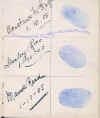 |
Constance M Hughes 1/10/05 | 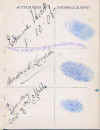
|
Edwina Hicks ? 1/10/05 |
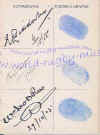
|
E Liddenson ? 6/10/05 |
| Sara C Bradford 1/10/05 | Stanley Rees 1/10/05 | G ???? Langdon ? | H R Thompson 7/10/05 | ||||
| Frederick Bradford 3/10/05 | Mandi Read ? 1/10/05 | Dorothy Mills 8/10/05 | Wm Ino ? D Rees 29/10/05 | ||||
|
The Bradford Family
|
|||||||
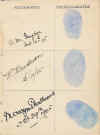
|
CM Gaydon 16/10/05 | 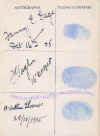
|
Fanny E Gage 16/10/05 | 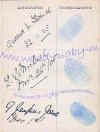
|
Queenie M Thomas 22/11/05 | 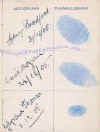
|
Sydney Bradford 31/12/05 |
| N Henderson 16/10/05 | F Gage 16/10/05 | LL Michael 26/11/05 | Ernie Morgan 24/12/05 | ||||
| Mervyn G Williams 29/10/05 | W Arthur Thomas 29/10/05 | G Jenkins Jones 1/12/05 | Glyndwr Thomas 8/12/05 | ||||
|
The 1905 All Blacks |
|||||||
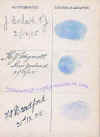
|
J Corbett NZ 21/12/05 | 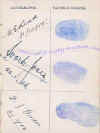
|
WE Read 31/12/05 | 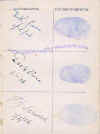
|
Dick Jones 2/2/06 | 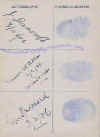
|
Jack Bancroft 3/2/06 |
| HJ Mynott New Zealand 21/12/05 | Ivor W Jones 20/1/06 | Dickie Owen 2/2/06 | James W Allen 3/2/06 | ||||
| FA Bradford 31/12/05 | FJ Gordon 2/2/06 | FG Scrine 3/2/06 | Charlie Pritchard 3/2/06 | ||||
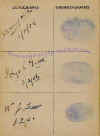
|
Bert Winfield 3/2/06 | 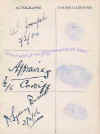
|
Will Joseph 3/2/06 | 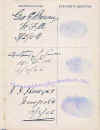
|
George Bowen WFU 3/2/06 | 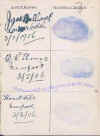
|
Jack Williams, London Welsh 3/2/06 |
| Rhys Gabe 3/2/06 | AJ Davies, Cardiff 3/2/06 | Arthur J Gould 3/2/06 | WR Thomas, Newport 3/2/06 | ||||
| Willie Trew 3/2/06 | I Sydney Boran 3/2/06 | Jehodia Hodges 3/2/06 | Tommy Vile 3/2/06 | ||||
|
Will Joseph & Paul Roos about to jump for the ball, Wales v SA 1906
|
|||||||
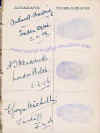
|
Arthur Harding, London Welsh 3/2/06 | 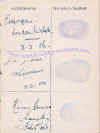
|
Teddy Morgan, London Welsh 3/2/06 | 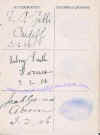
|
Reggie Gibbs, Cardiff 3/2/06 | 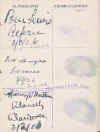
|
Ben Lewis, Referee 3/2/06 |
| HJ Maddocks, London Welsh 3/2/06 | Dai Jones, Aberdare 3/2/06 | Aubrey Smith, Swansea 3/2/06 | Ivor Morgan, Swansea 3/2/06 | ||||
| E Gwyn Nicholls, Cardiff 3/2/06 | Harry Bowen, Llanelly, Feb 3rd 06 | Jack Garmos ? Abercarn 3/2/06 | Harry V Watkins, Llanelli, Llandovery, 3/2/06 | ||||
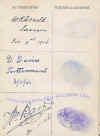
|
WR Arnold, Swansea, Feb 3rd 1906 | 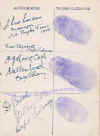
|
J Cecil Carden, Manager, SA Rugby Team 1906, Port Elizabeth, Cape Colony | 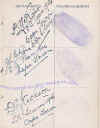
|
PA le Roux, SA Team 1906, Cape Town, Cape Colony | 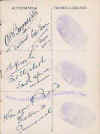
|
AR Burmeister, Sea Point, Cape Town, SA Team 1906-07 |
| D Davies, Porttennant 3/2/06 | PJ Roos, Capt, Stellenbosch, Cape Colony | JS Le Roux, SA Team 1906, Cape Town | JG Hirsch, Port Elizabeth, South Africa | ||||
| Wm Barr (y) ? 30/11/06 | DJ Brink, Stellenbosch, Cape Colony | DC Jackson SA Team 1906, Cape Town | H Gordon Reid, Pretoria, Transvaal | ||||
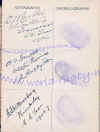
|
D Morkel, "Chowberg" Transvaal, SA Team 1906 | 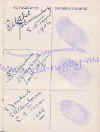
|
S Morkel, Johannesburg, SA Team 1906 | 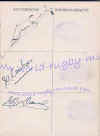
|
DS Mare | 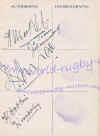
|
A Morkel, SA Team, Johannesburg |
| AF Burdett, Western Province, SA Rugby Team | AC Stegmann, Stellenbosch, South Africa | JA Loubser | J Krige | ||||
| AFW Marsberg, Kimberley, SA Team 1906-7 | S Joubert, Stellenbosch, SA Team 1906 | HJ Dannel | FJ Dobbin, Kimberley | ||||
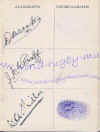
|
D Brookes | 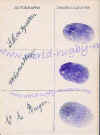
|
SC de Melker | 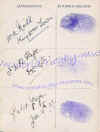
|
WA Neill | 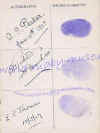
|
AG Parker, Jan 11th 1907 |
| JWE Raaff | WC Martheze | JDW Gage, Dec 9th | HM Richards, 10th March 1907 | ||||
| WA Millar | WA Burger | Gladys Gage, Jan 9th 07 | EP Thomas, 10/3/07 | ||||
|
THUMBOGRAPHS' MODERN LEGENDS of RUGBY There are numerous blank pages at the end of the thumbographs book. Our plan is to add the 'modern' legends of rugby football to the book to compliment the greatest players of the Victorian era. The first legend to add his Thumbograph was fittingly Gareth Edwards, voted on numerous occasions as the greatest rugby player ever. Gareth added his thumbprint during a BBC documentary on the 1905 Wales v All Black match, further details to follow of Gareth and other rugby legends as they join the long list of rugby superstars in 'Thumbographs - the pocket wonder' |
|
GARETH EDWARDS - WALES & BRITISH LIONS
(53 caps for Wales, 1st cap v France 1967, last cap v France 1978, 10 Test appearances for British Lions) Voted regularly as the "Greatest Player Ever" Edwards first made his debut as a 19 year old against France in 1967. He forged brilliant partnerships for Wales and the British Lions, firstly with Barry John then with Phil Bennett. He totalled 10 tests for the Lions and was ever present in the test series of the 1971 and 1974 tours. He also played in every game of the 1971, 1976 & 1978 Welsh Grand Slams. His final appearance was the 1978 Grand Slam decider against France in Cardiff where he dropped a goal. A brilliant all round sportsman he had a Welsh Trial at soccer, won the English Schools 200 yds hurdles title and has represented Wales at angling.
|
|
KEITH JARRETT - WALES & BRITISH LIONS
The scene is Cardiff Arms Park, the occasion, Wales
against the old enemy. This
was the last match of the 1967 Five Nations campaign, Amazingly this was his only appearance for Wales at full back, he wore the scarlet jersey another 9 times, each time at centre, scoring a further 54 points. In 1968 he was selected for the British Lions tour of South Africa playing in 5 matches with 18 points scored. 1969 was his swansong year in the Welsh team, he toured Australia, New Zealand and Fiji with Wales, playing in all but one match and scoring 52 points. On his return he turned professional with the northern union side Barrow. He represented Wales twice at Rugby league before retiring in 1973 because of ill health.
17th November 2010 Keith Jarrett
|
OTHER LEGENDS ADDED INFO TO FOLLOW
Chico Hopkins
Clive Rowlands
Colin Meads
Richie McCaw
Phil Bennett
|
DAI'S DIARY - 15/1/2018 - I MET PHIL BENNETT On the 15th January 2018 I met with the legend that is Phil Bennett at Parc-y-Scarlets in llanelli. There was huge buzz about the place, just a couple of days previously the Scarlets had demolished Bath at the Rec in the European Cup. Everyone was smiling including Phil. Why did I meet with Phil Bennett, let's turn the clock back 45 years to a time when I was twelve years old and off to Cardiff Arms Park for my first big match at the stadium, Barbarians v New Zealand 27th January 1973. This was a match that will live in the minds of many as the greatest rugby match there ever was. Myself included ! I was with 3 schoolmates and we had South Enclosure tickets, we were late getting into the ground and the game had already started. Once inside I couldn't believe how full the ground was, bodies jammed together, nowhere to stand, nowhere to sit, I was small and couldn't get to the front, there were a forest of people around me and I couldn't see a thing. We eventually managed to make our way up onto the steps that came down from the south stand and settled ourselves down with a limited view of the field. I looked up to see the All Black winger Bryan Williams kick ahead and Phil Bennett picked up the ball in his own 25, he started sidestepping All Blacks and the rest is history, with Edwards scoring in the corner right under our noses. Watching a playback of that try still makes the hairs on the back of my neck stand up, even after about the 200th + time, this happens at the same point every time, just before Bryan Williams kicks the ball. If you shut your eyes at this point and listen not to Cliff Morgan but only to the crowd, you get the feeling of what it was like to be there, turn up the volume to full at this point and hear the general crowd noise, then on Benny beating two players, you have the first roar, then 5 different higher levels of 'roaring' ending with Edwards in the corner. An incredible thing to witness and something I'll never forget...... Fast forward to 2018 and it is is now 12 years since I started collecting modern greats in my 'Thumb-o-graphs' book but from the outset it was always my intention to try and achieve the seven players who featured in 'the greatest try' I witnessed in 1973. Since then I've formulated a plan on who else I would like to add to the pocket wonder. Welsh legends, British Lions captains, Rugby World Cup winning captains and my favourite players from my watching days. Of the 5 categories Phil Bennett qualifies on four counts. The Rugby World Cup not having started until 1987 rules him out there. We could talk all day about his fantastic career for Llanelli, Wales, the British Lions and the Barbarians, he was the first Welshman to be capped as a reserve when he took the field at Stade Colombes in 1969, 28 caps later, he retired after captaining the Grand Slam victory over France in 1978, scoring two tries in the process. He starred in the Scarlets victory over the All Blacks in 1972 and also captained them in four successive cup final victories 1973-76. Phil Bennett O.B.E. is a true rugby legend and is generally regarded as one of the greatest players ever. The other rugby players I would consider as my favourites are Dai Morris, Elgan Rees and Shane Williams. Personal attributes are usually the key to why I admire these players, Dai Morris work rate and general presence were remarkable, I once played against him and tried to tackle him but it was like running into a lamppost, the man is made of granite. Elgan Rees had speed, strength and elusiveness, you never knew what he would do next but strength and speed were things I struggled with and I desperately wanted to be like Elgan. Everybody loves Shane Williams, his play was amazing but the thing I admire most about Shane was commitment to the fans. I can remember him signing autographs for the kids after a freezing night game at the Gnoll, all the other players had gone to get changed. Shane was so cold, he was shivering down to his bones but signed every last piece of paper he could for the children who idolised him. But what of Benny, the only non-Neath man amongst these players. I rubbed shoulders with him several times as I collected his autograph in the 1970s, he seemed a nice enough guy, I loved his sidestep, in particular the mesmerising one he did when he scored an amazing try against South Africa in 1974, the pinpoint accuracy when he kicked the ball was amazing too. But there is was more than this and I didn't know why I thought he was great. As I grow older and hopefully wiser, I try to understand why I favoured Phil. I think there is an invisible quality about the man, its what made him a great leader, for Llanelli, Wales and the British Lions. This quality may be invisible but it resonates when he speaks on the radio and television, how he champions his working class background, his pride in his village Felinfoel and his town Llanelli, the love he shows for his family and his friends. I've come to the conclusion that the man is an enigma, his heart is bigger than his person. This invisible quality I believe is 'passion', this is what makes him great, this is why he sidestepped in 1973, self belief, fuelled by passion. Phil Bennett is more than just a rugby great, he is a great leader but more importantly he is a great Welshman. |
1905 ALL BLACKS - 1905-6 WELSH TEAM & OTHER WELSH INTERNATIONALS - 1906 SPRINGBOKS -
COMPLETE LISTING OF ALL PAGES - MUSEUM HOME PAGE - RUGBY RELICS HOMEPAGE
|
ACKNOWLEDGEMENTS The information, illustrations and text used in this exhibit are from the following sources :- Wayne Thomas - A Century of Rugby Players, JBG Thomas - An Illustrated History of Welsh Rugby, Jenkins, Pierce & Auty - A Who's Who of Welsh International Rugby Players, Laubscher & Nieman - The Carolin Papers, EJL Platenauer - "The Springbokken Tour in Great Britain, Spaldings Athletic & Football Guide 1910, Gareth Hughes - "The Scarlets", Chester & McMillan - Encyclopedia of New Zealand Rugby, Wendy Allchin (Elsie Bradford's grand-daughter), Swansea Central Library. |
|
Thumbographs in print, on screen and on 'tour' The Thumb-o-graph book has been featured on BBC's 'Flog It' programme. Featured in an article about the Dai Richards' collection in The Sunday Times. - CLICK HERE Thumb-o-graphs was featured in the BBC Wales documentary on the 1905 Wales v All Blacks game where Gareth Edwards added his Thumbograph as the first modern player. Harry Mynnott & Jon Corbett's Thumb-o-graphs are illustrated in John McCrystal's book on the 1905 All Blacks "The Originals" published 2005 by Random House, NZ Thumbographs is exhibited at the Neath Rugby 125 Exhibition - CLICK HERE TO SEE THE EXHIBITION |
Thank you for visiting this page. If you are able to contribute any other stories, photos or information to this page, please email us. |
related exhibits
Wales v NZ - 1906-07 Springboks
CLICK HERE TO VIEW INDIVIDUAL PLAYER TEAM POSTCARDS
|
... ...
|
The World-Rugby-Museum is hosted and supported by Rugby Relics Ltd |